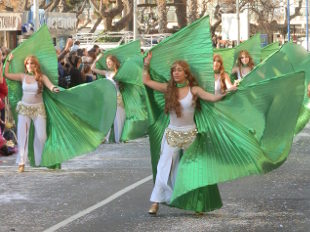Palamos and carnival
 Palamos, like nearly all the Costa Brava towns has a large carnival procession to celebrate the coming of Lent where people dress up, dance and compete for the best show in town. In Catalonia, as with many European Catholic regions, carnival has developed into a grand tradition even though it was actually banned in Franco's time. The modern festivals are now enormous. Palamos had about 50 floats this year and the amount of work put into costumes and practicing dance routines is huge often with 40-50 dancers in matching outfits following a float blaring out their dance music.
Palamos, like nearly all the Costa Brava towns has a large carnival procession to celebrate the coming of Lent where people dress up, dance and compete for the best show in town. In Catalonia, as with many European Catholic regions, carnival has developed into a grand tradition even though it was actually banned in Franco's time. The modern festivals are now enormous. Palamos had about 50 floats this year and the amount of work put into costumes and practicing dance routines is huge often with 40-50 dancers in matching outfits following a float blaring out their dance music.
 There are carnival processsions is most of the major towns (except for Palafrugell which has a Festa de Primavera at the end of May instead), but rather than having competing carnival processions, the festivities are often staged on different days in different places. This allows the carrossellers to attend more than one festival. For instance, floats from Sant Feliu de Guixols on a Friday would then visit Platja d'Aro or Palamos on the Saturday and then move to a different town on the Sunday.
There are carnival processsions is most of the major towns (except for Palafrugell which has a Festa de Primavera at the end of May instead), but rather than having competing carnival processions, the festivities are often staged on different days in different places. This allows the carrossellers to attend more than one festival. For instance, floats from Sant Feliu de Guixols on a Friday would then visit Platja d'Aro or Palamos on the Saturday and then move to a different town on the Sunday.
 The processions in Palamos this year was reported at about 50 floats (I believe some others got up to closer to 80). The floats naturally follow the procession route but not as a steady moving stream.
The processions in Palamos this year was reported at about 50 floats (I believe some others got up to closer to 80). The floats naturally follow the procession route but not as a steady moving stream.
At one point (usually towards the end) there is a judges stand where each float and troupe takes the time to show and perform their choreography danced routine for 3-4 minutes. If you count 3-4 minutes per float and 50 floats plus time for walking and changeover it won't be surprising that a typical big carnival procession takes at least 4-5 hours to complete. The early floats starting in the daylight at the end of the afternoon, with the last ones coming in when its dark.
 Though the fun of taking part and showing off is a big part, a hidden incentive are the prizes for the best carrossers. There are normally different categories from best large float, best small float, best local float, best dance routine etc and for some of the main categories prize money can reach €1,000 for the winning float - though almost all of this prize money will be reinvested to build a bigger better float for the next year.
Though the fun of taking part and showing off is a big part, a hidden incentive are the prizes for the best carrossers. There are normally different categories from best large float, best small float, best local float, best dance routine etc and for some of the main categories prize money can reach €1,000 for the winning float - though almost all of this prize money will be reinvested to build a bigger better float for the next year.
 The run up to carnival (or carnestoltes) has children going to school in fancy dress (disfreses) with essentially a big party atmosphere all weekend - slightly amplified this year by Valentines Day, though Valentine's is somewhat new in Spain.
The run up to carnival (or carnestoltes) has children going to school in fancy dress (disfreses) with essentially a big party atmosphere all weekend - slightly amplified this year by Valentines Day, though Valentine's is somewhat new in Spain.
Palamos itself is an old royal port with an old central part and large fishing fleet. The main port is large enough for big ships and through the summer regularly gets visits from smaller cruise ships. Around the main port area and through the older part of the town there are many good restaurants and bars and streets that climb up and down across the headland in the heart of the old town.
 At the end of the headland is the new marina and around the corner is the extremely pretty soft-sand bay of La Fosca making the whole town one of many contrasts.
At the end of the headland is the new marina and around the corner is the extremely pretty soft-sand bay of La Fosca making the whole town one of many contrasts.
One downside for first time visitors is that Palamos has three enormous ugly tower blocks built just off the main beach and the blocky newer area behind the main beach passeo-walk both of which lack ambience and character which can leave a poor first impression. Our reaction on first visiting Palamos was that we didn't really care for the newer parts, but now we visit more often, we've found it growing on us as a town - it has a strong local character and joie de vivre that makes the place interesting year round.

 Walks and other things
Walks and other things